|
Smith & Wesson created quite a ruckus
in the handgun world a couple of years ago when they introduced
their big X-frame revolver chambered for the .500
Smith & Wesson Magnum. Some shooters
immediately hated it, while others instantaneously loved it, and
neither had seen or fired one. My first reaction upon handling
one was like most otherís: "That thing is huge!",
and it was. It was also a huge seller, and still is, as far as
big revolvers go. It is not a gun that you stick in your
back pocket and forget that it is there. It is, however, a
revolver with plenty of power to take any game animal on Earth,
and makes for an excellent primary hunting arm for those who
prefer the handgun. It is within this same niche that
falls the .460 XVR, but with added versatility.
The .460 XVR is S&Wís latest chambering
for their big X-frame revolver. This is the same five-shot
cylinder as the .500 S&W Magnum, but the .460 uses a longer
case. It is, basically, a stretched .454 Casull, which is a
stretched .45 Colt. However, the .460 maximizes the available
cylinder length on the S&W X-frame. The cylinder on the .460
measures 2.305 inches long with a diameter of 1.920 inches. The
gun is constructed primarily of stainless steel, and it has
plenty of it in the beefy cylinder walls. This allows the .460
to operate at magnum rifle pressures, propelling a factory
loaded 200 grain Barnes X bullet at an advertised
velocity of 2300 feet-per-second (fps). From my sample
revolver, that Cor-Bon factory load averaged a bit
better, chronographing at 2358 fps from the eight and
three-eighths inch barrel. The barrel also has an unusual
rifling configuration for a production revolver, using a gain
twist*, reportedly for enhanced accuracy. The XVR comes in a
hard plastic case, and is supplied with two different
interchangeable recoil compensators. The gun wears a Hi-Viz
fiber optic front sight, but is also supplied with a black
post-style front sight. The rear sight is standard S&W
adjustable, and the gun is drilled and tapped for a scope mount.
The sample gun weighed exactly seventy-three ounces, and
measured fifteen inches in length with the longer of the two
compensators installed. It has S&Wís internal key lock,
and wears a set of semi-soft synthetic grips.
The fit and finish on my sample XVR is
excellent. The barrel/cylinder gap measured .003 of an inch. The
trigger pull was typical Smith & Wesson: superb. The double
action pull was butter-smooth and measured nine pounds and nine
ounces, and the crisp single action measured just under three
and three-quarters pounds, and felt even lighter. The trigger
pull could not be better for a gun of this type. It is light
enough for good target work, but not so light as to be a danger
under field conditions.
The gun functioned perfectly during all testing,
and I shot it a lot. It shot it with factory loads in .45 Colt,
.454 Casull, and .460 S&W Magnum. I shot lots of handloads
through the gun with bullets weighing between 200 and 360
grains. While the big .460 has plenty of power, recoil was not
at all painful. Compared to the recoil of the .500 S&W
Magnum with heavy loads, the .460 is a pussycat. The compensator
and rubber grips do an excellent job of taming the felt recoil.
The .500 would wear me out with heavy loads, but the .460
allowed long sessions of testing without fatigue.
While the .460 is a velocity champ with factory
200 grain loads, I was interested to see how it would perform
with heavy bullets. I like heavy, blunt bullets for hunting the
big stuff, so most of my testing was towards that end. The
factory Barnes X bullet is designed for a flat trajectory, and
should prove just dandy for long-range (from a hand gunning
perspective) hunting of deer, antelope, and elk. With a 150 yard
zero, the Barnes X is only four inches low at 200 yards, with
just under 1800 fps of remaining velocity. Not too shabby.
With the factory load having the high velocity/flat trajectory
pretty well covered, I was anxious to see how the big case would
handle the heavy bullets.
Working up loads for the .460, I had no load
data available. None. Keep in mind that all data listed here is
by careful experimentation. None of it has been pressure tested,
and I by no means suggest that the reader try to duplicate any
of it. Pressure tested load data should be available very soon
from sources such as Hodgdon Powder Company. I show this
to illustrate my findings with the test gun only. Others much
more qualified than I are working on load data for the .460
Magnum.
I tried several powders that I was certain would
be useful in this big cartridge. I also tried powders that I
hoped would be useful in this big cartridge. Notice that with
some powder/ bullet combinations, I reached the point where
adding more powder gained no more velocity. There were a couple
of instances where more powder resulted in less velocity,
particularly with LilíGun.
I canít explain it; it just happened that way. Within
the loads listed, there proved to be some useful combinations
with heavy bullets. The temperatures were fairly warm and humid
during all tests, with air temperatures between 85 and 96
degrees. Federal Gold Medal large rifle primers were used
in all loads. Powder and bullet weights are listed in grains.
Velocities are listed in feet-per-second. All chronograph
testing was done at twelve feet from the muzzle with a PACT
chronograph.
These are most of the results of my load
testing:
| Powder |
Charge Weight |
Bullet |
Velocity |
| Lil' Gun |
39.2 |
250 Hornady XTP |
1681 |
| Lil' Gun |
39.2 |
CP 335 WLNGC |
1766 |
| Lil' Gun |
39.2 |
CP 360 WFNGC |
1732 |
| Lil' Gun |
39.2 |
Belt Mountain 305 Punch |
1571 |
| Lil' Gun |
39.2 |
360 Keith |
1727 |
| Lil' Gun |
39.2 |
200 Barnes X |
1871 |
| Lil' Gun |
42.8 |
Belt Mountain 305 Punch |
1718 |
| Lil' Gun |
45.0 |
200 Barnes X |
1918 |
| Lil' Gun |
47.5 |
200 Barnes X |
1883 |
| Lil' Gun |
47.5 |
CP 360 WFNGC |
1852 |
| Lil' Gun |
48.3 |
CP 360 WFNGC |
1864 |
| Lil' Gun |
51.0 |
CP 360 WFNGC |
1843 |
| Reloder 7 |
44.5 |
CP 360 WFNGC |
1587 |
| H110 |
51.0 |
200 Barnes X |
2090 |
| H110 |
53.0 |
200 Barnes X |
2269 |
| H110 |
53.3 |
250 Hornady XTP |
2088 |
| H110 |
53.3 |
200 Barnes X |
2224 |
| H110 |
50.0 |
Belt Mountain 305 Punch |
1877 |
| Trail Boss |
14.0 |
Mt. Baldy 270 SAA |
1032 |
| Trail Boss |
15.0 |
Mt. Baldy 270 SAA |
1034 |
| H4227 |
42.5 |
CP 335 WLNGC |
2064 |
| H4227 |
42.5 |
CP 360 WFNGC |
1737 |
| H4227 |
42.5 |
Belt Mountain 305 Punch |
1651 |
| Titegroup |
11.0 |
Mt. Baldy 270 SAA |
1110 |
| Titegroup |
12.4 |
Mt. Baldy 270 SAA |
1198 |
Many loads tested were not listed above, as the
results were unsatisfactory, with some indicating excessive
pressure. Neither are the loads listed above recommendations.
Hodgdon 110 proved to be the best for the 200 grain Barnes X
bullet, resulting in high velocity, easy case extraction, and
good accuracy. With the heavy 360 grain bullets from Cast
Performance and Mt. Baldy,
LilíGun and H4227 proved the best. Reloder 7 displayed
good accuracy, but the velocity wasnít there. For mild
and accurate target and medium game loads, the Mt. Baldy 270 SAA
loaded with Titegroup or Trail
Boss worked very well. For deep penetration, the Belt
Mountain Punch bullet loaded over H110 is a good
choice, as are the heavy 360 grain bullets from Cast Performance
and Mt. Baldy.
Once again, this load data is all experimental.
I look forward to more testing as reliable data becomes
available. The accuracy of the big .460 XVR was outstanding. As
can be seen in the pictures, keeping five shots at just over the
one inch mark at twenty-five yards could be performed with ease
from a rested position. I wished that I had a scope mount
available for long range accuracy testing . Maybe later, as I am
not finished with this revolver yet.
As stated earlier, the big .460 was pleasant to
shoot, becoming a bit harder to handle as I pushed the heavy 360
grain bullets towards 1800 fps, but still not painful even at
that level. While the .500 S&W Magnum offers more power with
the heavier bullets, the .460 S&W Magnum offers a flatter
trajectory, and more versatility. It is suitable for hunting
anything from jackrabbits to grizzly bear on this continent, and
warthogs to Cape buffalo on the other side of the world. It is
accurate enough for target shooting, and has one of the slickest
actions of any production revolver available. It shoots flat
enough for 200 yard antelope hunting, if the shooter can do his
part. It is big and heavy, but more compact than most of
the single-shot hunting handguns available, and carries five
rounds in the cylinder. It is not a belt gun, but carried in an
across-the-chest holster, it is about as handy as a gun with
this much power can be. The .460 XVR pushes a 200 grain factory
load faster than any production revolver available. Handloaded,
it can push a 360 grain bullet 400 fps faster than does the .454
Casull. It is accurate, strong, and built to last. And it is
also a Smith & Wesson, built in the USA by some of the
nicest Yankees that you will ever meet. I like it.
Check out the extensive line of Smith &
Wesson products at: www.smith-wesson.com.
For factory loaded .460 S&W Magnum
ammunition, go to: www.cor-bon.com.
For more information on the bullets tested, go
to: www.castperformance.com,
www.mtbaldybullets.com,
www.barnesbullets.com,
www.hornady.com, and
www.beltmountain.com.
Jeff Quinn
*Gain twist rifling has a gradual increase in
the twist of the rifling in the barrel, allowing the bullet to
gradually increase its rotational speed. This type of rifling
allows the bullet to fully engage the rifling before it starts
the rotational spinning, avoiding deformation of the bullet.
NOTE: All load data posted on this
web site are for educational purposes only. Neither the author nor
GunBlast.com assume any responsibility for the use or misuse of this data.
The data indicated were arrived at using specialized equipment under
conditions not necessarily comparable to those encountered by the
potential user of this data. Always use data from respected loading
manuals and begin working up loads at least 10% below the loads indicated
in the source manual.
  
Got something to say about this article? Want to agree (or
disagree) with it? Click the following link to go to the GUNBlast Feedback Page.
|
|
Click pictures for a larger version.

Smith & Wessonís .460 XVR Magnum Revolver.
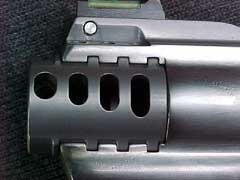
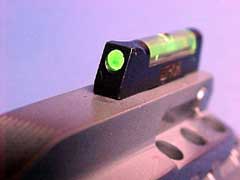
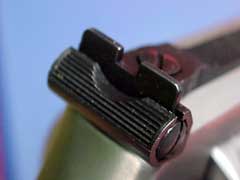
The .460 XVR comes with user-changeable Hi-Viz front
sight and S&W's legendary fully-adjustable rear sight.

The top strap is also drilled & tapped for scope
mounts.

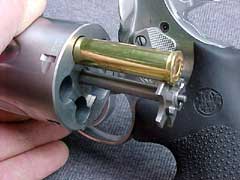
The 460 XVR uses the same basic 5-shot cylinder as the
S&W .500, allowing plenty of beef between chambers for
high-pressure loads.

The .460 XVR comes with 2 different muzzle compensators
and 2 front sights, allowing a great deal of versatility and
user customization right out of the box.
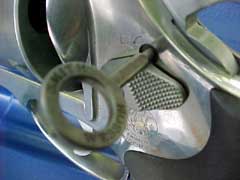
Like all their current production guns, S&W's .460
XVR features a key-locking safety system.
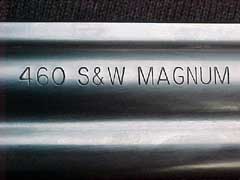
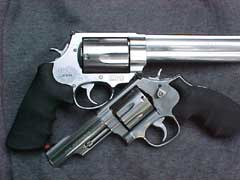
The .460 XVR (top) is shown with a S&W
Model 620 .357 Magnum revolver for comparison.

The .460 XVR fires (left to right) .45 Colt, .454
Casull, and .460 S&W Magnum ammunition.

The .460 S&W Magnum is flanked by two other modern
behemoth cartridges, the .500 S&W Magnum (left) and .50
Beowulf (right).
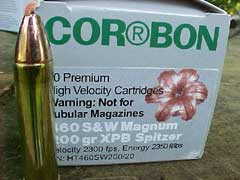
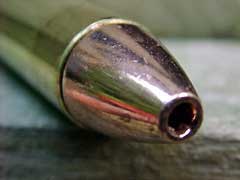

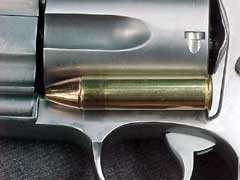
Cor-Bon's 200-grain spitzer hollowpoint load is an
excellent and flat-shooting choice for the .460 S&W
Magnum.
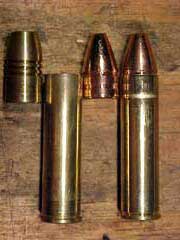
Despite its size, Belt Mountain's 305-grain Punch Bullet
takes up very little case capacity.
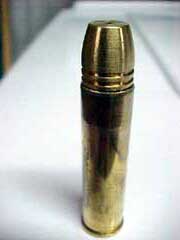
The great cylinder length of the .460 XVR allows Belt
Mountain's Punch Bullets to be seated out to maximize case
capacity.
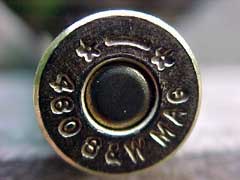
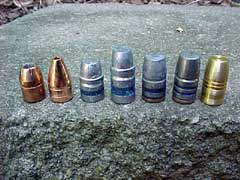
Bullets tested in the .460 XVR included (left to right):
250-grain Hornady XTP hollowpoint, 200-grain Barnes X
hollowpoint, 270-grain and 360-grain Mt. Baldy Keith-type
semi-wadcutters, 335-grain and 360-grain Cast Performance LBT-type,
305-grain Belt Mountain Punch Bullet.

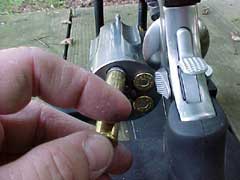

Author used a new pistol rest from Hyskore Shooting
Products for accuracy testing. The fully-adjustable
Hyskore rest is just the ticket for benchrest shooting with a
wide variety of handguns.


S&W's .460 XVR proved to be very accurate, turning
in groups like this all day with a variety of loads.
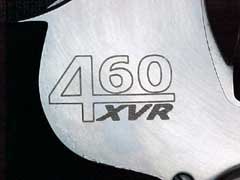
|
![]()